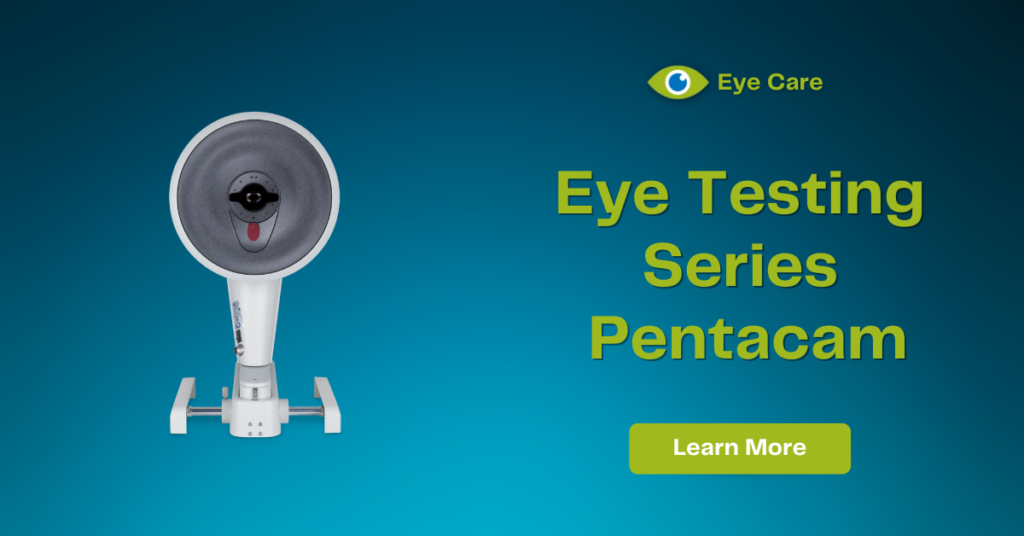
The Pentacam is a machine that takes a topography of the cornea, that clear front window of your eye. What does that mean? What does it show your doctor? Why does your doctor want it? We’ll answer all these questions in this entry in our series on the different equipment we use around our office.
What is a Corneal Topography?

A topography is a map that gives height and depth to a 2-dimensional image. On conventional maps, it can show where mountains and valleys are.
Your cornea is the front clear window of your eye. While we like to think of our eye as round, nothing in nature is perfectly round. So, your cornea has different peaks and valleys as well.
What does a Pentacam Show?

Here, we’ll show a few different example Pentacam results. The Pentacam is giving a mapping of the curvature of your cornea.
There are two basic patterns that we’d consider normal: either the first image shown here of a relatively round cornea or one with a bowtie shown below.
The round cornea shows up as concentric rings. The outer rings are lower in elevation and the inner circle is the peak elevation, showing a normal dome.

The bowtie pattern shows a higher ridge in one direction than in the other direction. This is the classic appearance of “astigmatism”, which means that your cornea isn’t perfectly round.
The two orange sections are like two peaks of mountains and the green/yellow running between them is a valley between the peaks.
Now, this is what we’d call “regular” astigmatism, which has a uniform and symmetrical pattern. This is easily corrected by glasses or contact lenses.

The final topography we’ll look at in this section is one with no clear symmetrical pattern. There’s a pit/depression in the purple area specifically, and it continues to get higher surrounding it.
This is an example of “irregular” astigmatism. Again, the cornea is not completely round, but also it’s asymmetrical.
This type of astigmatism is not easily corrected with glasses. Specialty contact lenses may be required to help re-shape your cornea or otherwise correct for the irregularity.
Why Does My Doctor Order a Pentacam?
You may have guessed from the previous section that the Pentacam is a great tool for measuring astigmatism. It gets much more in depth than some of the other ways we can measure it, like your glasses prescription.
We also use the Pentacam to document and track various disease states and abnormalities of the cornea. Many injuries are helpful to track with this device, such as a corneal ulcer or other scars. Some conditions are known to cause irregular astigmatism, like keratoconus. This disease can be progressive, so your doctor will likely keep track of it annual with a new measurement.
We can use the Pentacam for other purposes as well, such as measuring how thick your corneas area (useful in Glaucoma care and LASIK measurements) and how long your eye is (useful for cataract surgical measurements).
What is a Pentacam Like?
It’s common to feel a little apprehensive of any new test. Thoughts of “why do I have to do this”, “is there something wrong”, and “will this hurt?” often flash through people’s minds as they consider these tests. Hopefully, we’ve already answered the first two, and we can assure you that it does not hurt.
You’ll need to look at the machine and stay focused on a small, flashing circle. The measurement itself takes approximately 2 seconds. During this time, a light spins around and takes 25 photos of your eye from different angles.
It’s important to keep your eyes as open as possible during the measurement so the machine can capture all the details of the cornea. Rarely, prominent brow bones or even masks will get in the way of the photos. Your skilled technician will troubleshoot and ensure we get the best measurements.
The machine compiles all these photos and creates the 3D map of your cornea.
The light is fairly bright and you will notice some after-images for a minute or two.
Summary
We hope this article has helped you understand what a Pentacam is, why your doctor might order it, and how easy it is to do. We’re always happy to answer more questions during your visit.